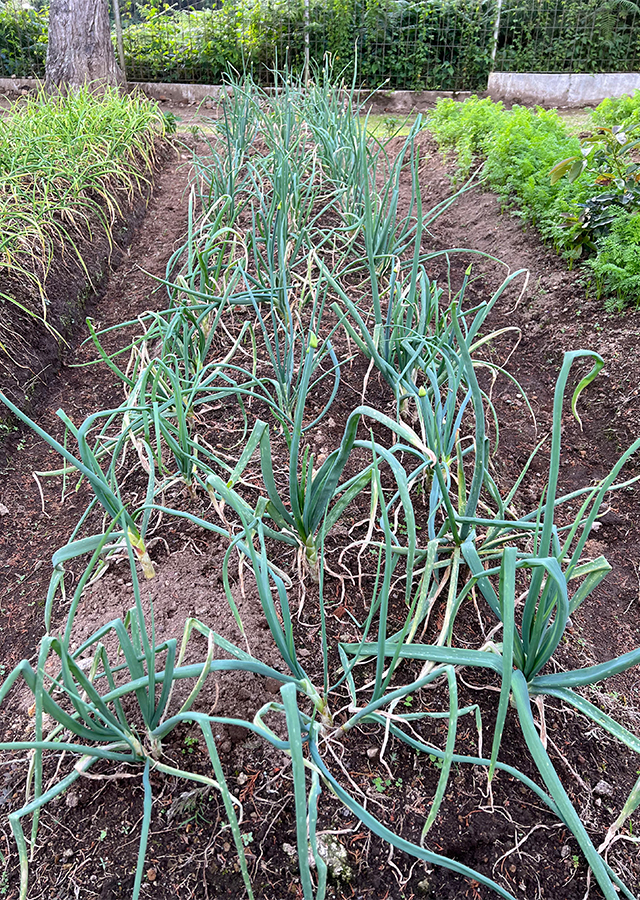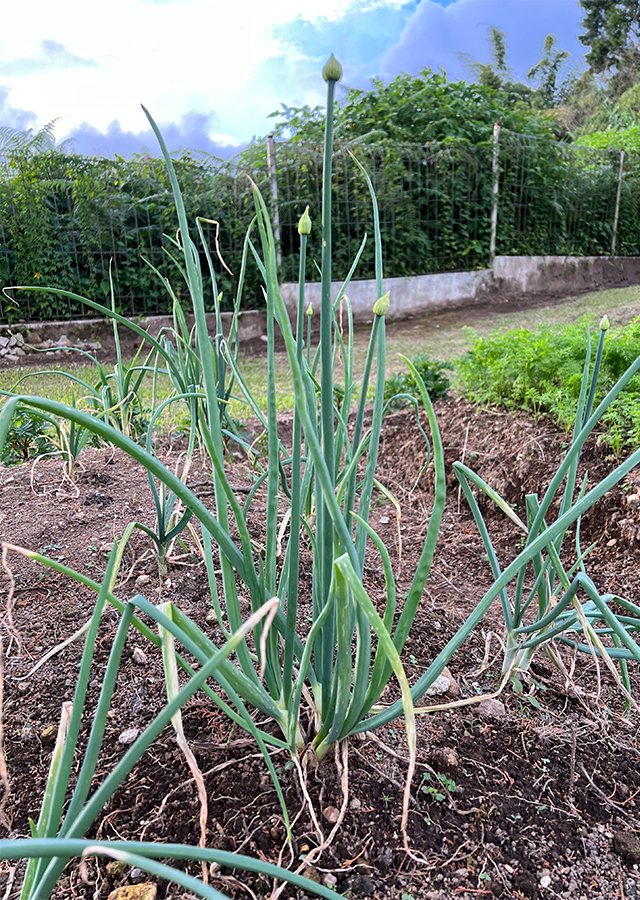Onion
Allium cepa L.
Amaryllidaceae
Location in our garden
Vegetable



Synonym
Allium angolense Baker
Allium aobanum Araki
Allium commune Noronha
Habitus
Herbaceous. A herbaceous, perennial plant, producing 4 - 10 leaves about 30 cm long
Part Used
Tuber
Growing Requirements
Full Sunshine
Habitat
Mountains
Terrestrial
Overview
The earliest onion depictions originated in Egypt and date back to about 2700 BC; consequently, domestication must have begun much earlier. Onion was introduced into western and northern Europe by the Romans about 300 AD. It became widespread in Europe during the Middle Ages and was introduced to the Americas by Columbus. South-western Asia can be acknowledged as the primary gene centre of variability. The onion was one of the first plants to be cultivated for food and medicine. It is very widely cultivated in most parts of the world for its edible bulb and leaves, there are many named varieties capable of supplying bulbs all the year round.
Vernacular Names
Anian (Papua New Guinea), Sibuyas (Tagalog-Philippines), Khtüm barang (Cambodian), Hom-yai (Thai), Hành củ (Vietnam), Bwàx fàlangx (Laos)
Agroecology
Onions are best grown in a Mediterranean climate, the hot dry summers ensuring that the bulbs are ripened fully. For best growth, however, cool weather is desirable at the early stages of growth. Optimum growth takes place at temperatures between 20 and 25 °C. Prefers a sunny sheltered position in a rich light well-drained soil. Plants tolerate a pH in the range of 4.5 to 8.3.
Morphology
- Roots - adventitious, within a radius of 30 cm from the stem in the top 30 cm of the soil.
- Stems - very short, flattened, formed at the base of the plant; pseudostem formed by the sheathing leaf-bases.
- Leaves - alternate, distichous, glaucous, produced in succession from the broadening stem apex, each arising as a ring which elongates to form the tubular leaf-sheath; leaf-blade cylindrical, at first solid, later becoming hollow, up to 50 cm long, top acute.
- Bulb - formed by the thickening of leaf-bases a short distance above the stem; outer leaf-bases thin, fibrous and dry, variously coloured, forming the protective bulb-coat; mature bulb (the onion) depressed globose to ovoid, up to 15 cm in diameter, very variable in shape, size, colour and weight.
- Flowers - subcampanulate to urceolate; tepals 6 in 2 whorls, ovate to oblong, 3-5 mm long, greenish-white to purple; stamens 6; ovary 3-locular, style simple, shorter than stamens at anthesis.
- Fruits - a globular capsule, 4-6 mm in diameter, splitting loculicidally, containing up to 6 seeds.
- Seeds - about 6 mm × 4 mm, black, wrinkled after drying.
Cultivation
Propagated by seeds - The soil should not be too rich and the seedlings will not grow very large in their first year. The plants will produce a small bulb about 1 - 2 cm in diameter. A proportion of the bulbs will run quickly to seed but most should grow on to produce good sized bulbs.
Chemical Constituents
Quercetin, quercetrin, allyl disulphide, allyl, tianshic acid, N-trans-feruloyl tyramine, beta-sitosterol-3 beta-glucopyranoside-6'-palmitate, sitosterol, daucosterol, tryptophane, and adenine riboside.
Traditional Medicinal Uses
- The juice is disinfectant, rejuvinative, antispasmodic.
- The oil is considered stimulant, diuretic, and expectorant; bulb is emmenagogue, externally stimulant and rubefacient.
- Bulb, cooked and mixed with coconut oil, used as ointment and applied to the abdomen to promote diuresis.
- Bulb applied as cooling poultice for boils, bruises, and wounds; applied to the navel in dysentery and body heat.
- Juice of onion, mixed with honey, ginger juice, and ghee, used as aphrodisiac. Dropped warm into ears to relieve earaches; applied hot to the soles of feet for convulsive disorders. Inhaled in epistaxis; applied to the eyes in dimness of vision. And is used like smelling salts for faintness, in infantile convulsions, headache, epileptic and hysterical fits.
- Mixed with common salt, is used for fever, catarrh, chronic bronchitis.
- Mixed with mustard oil in equal proportions and applied to rheumatic pains and other inflammatory swellings.
- Mixed with vinegar for use in sore throat; cooked in vinegar for jaundice, splenic enlargement, and dyspepsia.
- Eaten with jaggery to stimulate growth in children.
- Juice or slices of raw onion is applied to insect bites and stings or burns.
Part Used
Reference Sources
- http://temperate.theferns.info/plant/Allium+cepa
- https://uses.plantnet-project.org/en/Allium_cepa_Common_Onion_(PROSEA)
- http://www.stuartxchange.com/Sibuyas.html

